Galápagos birds expand their eating habits
Loading...
Hunger has a funny way of making otherwise picky eaters a little more adventurous.
On the Galápagos Islands, where plant and insect diversity is low, virtually every land bird has expanded its diet to include flowers and nectar. And while that might be good news for the birds, it could have potentially negative after-effects for the island environment. According to research published today in Nature Communications, the phenomenon is unprecedented.
A research group led by Anna Traveset, of the Institut Mediterrani d’Estudis Avançats (IMEDEA), observed the feeding habits of 19 Galápagos bird species. Over time, the team carefully mapped out each species’ interactions with over 100 plant species on the archipelago.
Dr. Traveset and her team found that nearly every species of land bird on the entire archipelago had expanded its diet to include flowers and nectar. They recorded 421 bird-plant network connections on the archipelago – 20 times that of previous estimations. It was an ecological anomaly – island species widening their feeding niche to compensate for food scarcity, thus interacting with more native species than their mainland relatives.
“At present, we expect it to be a general oceanic island phenomenon, but no comparable data are yet available,” Traveset wrote in the study.
This phenomenon has been reported for single species, but never before for an entire ecological community. As such, Traveset’s team was tasked with coming up with a name for the phenomenon – they settled on “interaction release,” a subconcept of “ecological release.” The latter occurs when species introduced to foreign environments either establish a local population or die out.
Obviously, generalized feeding habits benefit the birds of the Galápagos – survival is the ultimate ideal for any species. But the environmental impacts of this phenomenon remain to be seen.
“Interaction release is crucial to the survival of native birds but simultaneously threatens the unique biodiversity of this archipelago,” the study reads, “as the birds also visit invading plants, likely facilitating their integration into pristine native communities.”






